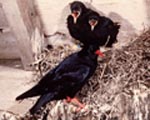Turning population ecology into conservation strategy
Published: 13 March 2006
University researchers explore a sustainable environment for a rare species of bird
With the help of funding from the Natural Environment Research Council, Scottish Natural Heritage and the RSPB, researchers at Glasgow and Aberdeen Universities will work closely with decision makers in developing a suitable environment to protect a rare species of bird: the red-billed chough.
The rarity of this species means that the UK government is required to put in place appropriate measures for its conservation, which needs to be underpinned by scientific knowledge of what causes population changes.
In addition, the chough is one of a number of species that indicate parts of the UK where farmland is managed in a low-intensity, more traditional, way - and where biodiversity remains high in conjunction with commercial farming.
Under the Natural Environment Research Council's 'Connect B' Knowledge Transfer grant scheme, a new partnership has formed to enable University scientists to work closely with those involved in legislation, conservation and land management, over the next three years.
The project builds on the long-term studies of choughs undertaken by Islay-based Sue and Eric Bignal, David Jardine on Colonsay, and other members of the Scottish Chough Study Group, together with Professor Pat Monaghan at the University of Glasgow, Dr Jane Reid at the University of Aberdeen and Dr David MacCracken of the Scottish Agricultural College. Post-doctoral research assistant Dr Maria Bogdanova from Bulgaria has also been appointed for the duration of the project.
The academics will work alongside Scottish Natural Heritage, the Royal Society for the Protection of Birds (RSPB), and the Scottish Agricultural College, to provide a direct route for fundamental science to feed into conservation practice, to the benefit of choughs as well as other important plant and animal communities that rely on the Hebridean agricultural environment being appropriately managed and protected.
Professor Pat Monaghan explains:
'Birds are a particularly important feature of the environment, both because of their intrinsic attractiveness and their value as a sensitive indicator of environmental conditions. The red-billed chough is a flamboyant member of the crow family. It is one of the UK's flagship bird species and has a very restricted European distribution.'
'In Scotland, red-billed choughs are confined to the Inner Hebridean Islands of Islay and Colonsay, where they are associated with the low intensity, pastoral agricultural systems typical of these beautiful islands.'
'It is of great importance therefore that both the landscape and biodiversity are appropriately protected, managed and utilised in a sustainable way, which is recognised in the proposed Scottish Rural Development Plan. To do this, we need the right combination of scientific knowledge, legislation, sound judgement and advice.'
Eric Bignal added: "Our 25 year study has shown that what happens to birds in their first six months after leaving the nest is crucial. We are planning intensive observations that will give us a better understanding of their requirements during this period, and we will relate these to land management practices where possible. We are optimistic that we will be able to provide the advice needed to substantially improve current conservation practices."
Media Relations Office (media@gla.ac.uk)
For more details please contact the University's Media Relations office on 0141 330-3535
First published: 13 March 2006
<< March


